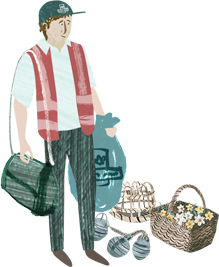Soil health in bulb fields
Good soil health = good narcissi
It is a rather obvious truth that soil health is a cornerstone of sustainable agricultural production. If you don't look after the stuff you rely on to grow things you're never going to get very far in the long term. But with constant pressure to produce more for less it could be argued that farmers have exploited this complex and delicate resource to remain, 'in the game'. Or maybe it is unfair to place the blame solely at the door of farmers and we should instead look more deeply at the root cause of the pressure?

Back to that chicken
So why did the chicken cross the bulb field? Well in all honesty it was pure clickbait to go with a cute picture. The simple and obvious answer is to get out of the way of the bulb-picker-uppera. Our rather elderly chicken had been enjoying the warm, bare sandy soil and its associated easy access to chicken snacks (aka insects and worms), that were provided in the process of lifting and processing bulbs. One chicken of course is not enough livestock to impact soil health even in our tiny fields but the integration of a small beef herd onto our farm has improved the way we farm and the health of our soil.

Growing scented narcissi is a fairly intensive process. We keep the bulbs in the ground for 4-5 years, then lift them and work to regain soil health, both in terms of increasing organic matter and preventing the build up of disease. We then 'rest' the land for 3-4 years. Rest is not really a good term as it implies inaction rather than what actually happens which is a very considered process of active soil management. Soil on Scilly is inherently poor. Due to the granite bedrock it is unsurprisingly sandy and acidic, it is therefore even more important that we do what we can to improve it.

Active management
That active soil health management will be a mixture of things:
- planting a mixed break crop that has a good proportion of nitrogen fixing legumes. Covering the soil also prevents erosion. This crop will then be rotavated in to increase organic matter in the soil.
- planting grass for haylage that once established can be drilled with a herbal lay to improve the biodiversity of the grass. This in turn supports a more diverse population of invertebrates and it produces better quality haylage.

- doing the same but allowing the cows to graze it. The obvious benefit being the instant application of manure via cowpats but also a wider diversity of invertebrate habitat that is created by the cow's hooves divoting the soil and the grass being left at different heights as it is grazed.
- planting fodder turnips for the cows to graze, This does most of the above but turnips will grow in the colder months when grass has stopped.
- rotavating in the coir blocks we use to grow our pinks. This increases the organic content of the soil and is a great way to dispose of what would otherwise be a waste product.

Encouraging results
We also monitor our soil health to make sure that what we are doing is working. Our latest soil health tests were positive with higher than expected levels of soil carbon and biological activity. We allowed ourselves a pat on the back but we won't be standing still. We are actively engaged at both a local level with knowledge sharing through the Isles of Scilly Nature Recovery project and at a national level via the Duchy of Cornwall and informal networks to identify and apply best practise.



